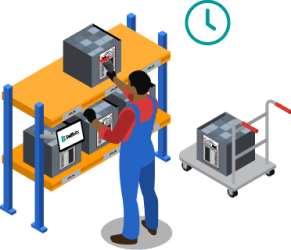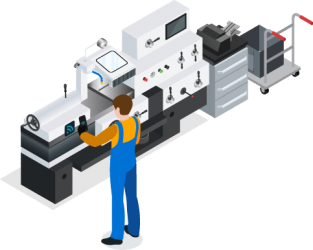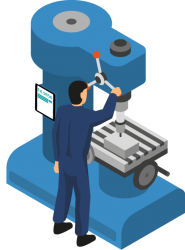Until now
In many companies, order status is recorded digitally only at two points: on release and on completion, when it leaves shipping. Although a finer-level recording is done on paper in the form of a goods receipt, the data is usually only time-delayed or not recorded in the software system of the company. Thus, the current order status is only known to the employees who are currently working on it.
If a customer contacts his sales representative to ask for the order status, no information is available other than the plan data. Depending on the importance of the job, the search is then carried out in the production itself. This means that the employee personally goes through the production steps and searches for his order. Obviously this is very time consuming and not very effective. After a successful search, he can call back the customer or inform him by e-mail about the current status and respond to his wishes.

New
Here, the Selfbits Manufacturing Suite offers a much simpler and more efficient method: During the call, the sales representative can call up the Web Dashboard of the Selfbits Manufacturing Suite and log in with his login data. The Manufacturing Suite has its own salesperson interface, which gives you information about the status of your production orders. There they can simply search for the customer or order number and see exactly how much has already been produced.
The Manufacturing Suite provides this functionality as all production jobs are managed digitally. Production planning can schedule the orders visually based on Gantt chart and employees on the shop floor are guided through the app on the tablet to the machines or their smartphones by the order. They report times, scrap, and completed quantities within the app.
In this way you gain transparency internally and can give your customers better service. At the same time, of course, this results in internal advantages for quality assurance and production management.
Functions of the Selfbits Manufacturing Suite that are used

Track & Trace
With the help of tablets and handheld scanners on the shop floor, the flow of goods and materials in production can be recorded. In the web interface, the material flows and inventories are visualized in real time.

Real-time capture of production data
Use tablets on machines or the flexibility of smartphones to record set-up times, machine downtime and reasons as well as good and bad parts flexibly in real time.

Digital production orders
Supply your employees paperless with production orders and relevant job information such as drawings, setting parameters, article descriptions and diagnostic procedures on tablets at machines and workstations.
FAQ
No. The Selfbits Manufacturing Suite is best compared to an integrated PDA/MDA and PPS/MES solution. Its goal is to depict the process from “dock-to-dock” as a digital twin along the value stream in as much detail as possible, capturing all relevant data centrally in the process. Based on this, core value creation can be optimized, and future production can be better planned. Master data such as articles, materials, and machines are synchronized from the ERP through interfaces or transferred once. All accounting processes continue to take place in the ERP.
Yes. All common ERP systems (SAP, ProAlpha, ABAS, Sage, Navision, Infor) offer interfaces to extract or input data. We would be happy to discuss with you the possibilities for integration with your existing ERP.
Yes. We are happy to help with the integration. Just contact us.
The Selfbits Manufacturing Suite offers interfaces via REST and GraphQL to access data. This allows for in-house development of solutions and integration with other software. Data exports to Excel are also possible.
Yes and no. Our standard operating model involves hosting on the secure AWS cloud in Frankfurt am Main. If you strictly require an on-premise license, please contact us so we can find a solution together.
The data is centrally stored and processed in the AWS Cloud in Frankfurt am Main. A separate VPC (Virtual Private Cloud) is set up for each customer to ensure data security. Learn more about this in our Privacy and Data Security Whitepaper.
It’s complicated. To our own surprise, we have found in collaboration with our clients that barcodes are often much cheaper and easier to handle than solutions using NFC or RFID. The choice of “carrier technology” ultimately always depends on the conditions in production. If you use large containers and automated handling technology, the tendency leans towards RFID. If you use small containers and there are process steps with extreme external factors such as temperature or moisture, barcodes are often the better option. We would be happy to discuss the details with you personally.
Yes. As long as something is mechanically moving or electricity is flowing, we are able to capture at least rudimentary process signals.
Selfbits Shopfloor Solutions
Boost your success
Take advantage of Selfbits flexible solutions to optimize your utilization and reduce waste.
